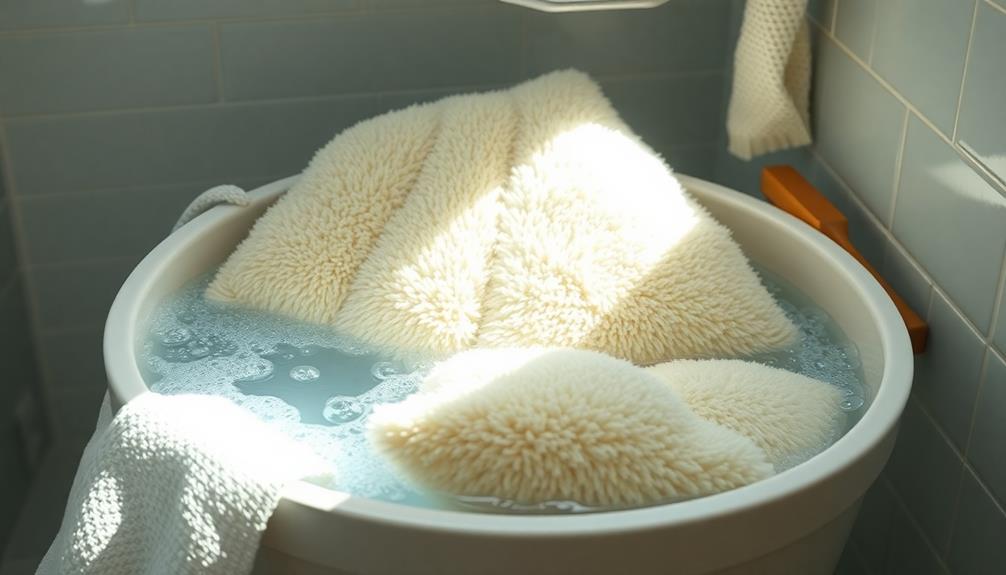To clean your sofa pillows, the first step is to review the care labels for specific instructions. If the pillows are removable, you can put them in the washing machine on a gentle cycle with cold water. For non-removable covers, use a mild detergent and a soft sponge to spot clean. Foam-filled pillows can be hand washed with a mild solution, making sure to rinse thoroughly. Allow them to air dry or use a low heat setting in the dryer with dryer balls to help fluff them up. Regular maintenance such as vacuuming and spot cleaning will keep your pillows looking fresh. Interested in more cleaning tips? Check out this link.
Key Takeaways
- Check the care label for specific washing instructions and fabric type before cleaning your sofa pillows.
- Use a vacuum to remove dust and allergens from the pillows before washing.
- For machine-washable pillows, use a gentle cycle with cold water; for non-removable covers, opt for spot cleaning.
- Air dry pillows or use a low heat setting in the dryer with dryer balls for fluffing and maintaining shape.
- Regularly fluff and vacuum pillows to keep them fresh and prevent flattening.
Check Care Labels

When you decide to wash your sofa pillows, the first step is to check the care labels. This essential action tells you the appropriate washing method and any specific cleaning instructions.
Look for symbols that indicate whether the pillows are machine-washable, hand-wash only, or require dry cleaning. Fabrics like silk and wool typically need dry cleaning, while cotton and polyester are often safe for machine washing.
It's also wise to take into account the potential for allergens in your pillows, much like understanding the importance of selecting the right cold medication for effective relief.
Pay close attention to any temperature guidelines provided on the label. Following these guidelines helps prevent fabric damage or shrinkage, ensuring your pillows stay in great shape.
If the care label is missing or unreadable, don't panic. You can think about spot cleaning those areas that need attention or consult the manufacturer for proper cleaning recommendations.
Cleaning Methods

To effectively clean your sofa pillows, it's important to choose the right method based on their care labels and construction. Always check the care tag before deciding how to wash your throw pillows. Here's a quick overview of effective cleaning methods:
| Cleaning Method | Suitable For |
|---|---|
| Machine Wash | Removable covers |
| Spot Clean | Non-removable covers |
| Hand Wash | Foam-filled pillows |
For removable covers, machine wash them on a delicate cycle using cold water and a mild detergent to preserve fabric integrity. If your pillows have non-removable covers, spot cleaning works best. Just apply a mixture of mild detergent and water to the stained area, then blot with a clean white towel.
If the pillow contains foam filling, hand wash it using a mild detergent solution. Be sure to rinse thoroughly and air-dry to prevent mildew. By tailoring your cleaning method to each pillow's specific needs, you'll guarantee they stay fresh and in great condition for years to come.
Washing Techniques

Understanding the right washing techniques for your sofa pillows can greatly enhance their lifespan and appearance. Start by checking the care label to see if your pillows are machine-washable. If they are, use a gentle cycle with mild detergent and wash them in cold water to prevent any damage or shrinking.
For ideal cleaning, consider using a vacuum to remove dust and allergens before washing, as this can help maintain their freshness and hygiene. For more tips on effective cleaning solutions, check out the Best Vacuums for Dust Removal in 2024.
For non-removable covers, you'll need to hand-wash them. Create a solution of cold water and mild detergent, then gently scrub the fabric with a soft brush or cloth. Be careful not to damage the material.
After cleaning, make sure to thoroughly rinse the covers to eliminate any detergent residue, as leftover soap can attract dirt.
Once you've finished washing, it's crucial to air dry your sofa pillows. If you prefer to use a dryer, opt for a low heat setting. Adding dryer balls can help fluff the filling and maintain the pillows' shape during the drying process.
Following these washing techniques will guarantee your sofa pillows remain fresh, clean, and looking their best for years to come.
Drying Instructions

Drying your sofa pillows properly is essential for maintaining their shape and comfort. Start by checking the care label for specific drying instructions. Most pillows can be dried on a low heat setting in the dryer. For added softness, toss in dryer balls or clean tennis balls to fluff the filling while drying.
If your pillows aren't dryer-safe, opt for air drying. Hang them in a well-ventilated area, and avoid direct sunlight to protect the fabric. Be diligent in ensuring your pillows are thoroughly dried to prevent mildew, which can develop if any moisture remains.
During the drying process, periodically fluff and reshape your pillows to maintain their form.
| Drying Method | Tips for Best Results | Common Issues |
|---|---|---|
| Low Heat Setting | Use dryer balls for fluffing | Mildew development |
| Air Drying | Hang in a well-ventilated area | Retained moisture |
| Periodic Fluffing | Reshape to maintain appearance | Loss of shape |
Maintenance Tips

Since maintaining your sofa pillows is essential for their longevity and appearance, it's important to incorporate a few simple practices into your routine. Regularly fluffing the pillows and rotating them can help prevent uneven wear and sagging. Additionally, knowing how to arrange pillows on sofa can instantly elevate the look of your living room by creating a balanced and stylish ensemble. Consider mixing different sizes, textures, and colors for a dynamic yet cohesive setup.
Start by vacuuming your pillows at least once a month to eliminate dust, pet dander, and allergens. This will keep them looking clean and fresh. Consider adding a few decorative touches to your living space, such as DIY Fire Pit Ideas, which can create a cozy atmosphere that complements your pillows.
If you notice any stains, don't wait—spot clean them immediately using a soft sponge and a mild detergent solution. This prevents deep-set stains from forming.
To keep your pillows in shape, shake and fluff them weekly. This simple act preserves their form and prevents the filling from flattening. Consider investing in removable pillow covers that can be machine washed every few weeks. This makes maintenance easier and guarantees your pillows stay clean.
When your pillows aren't in use, store them in a cool, dry place to protect them from moisture and potential mildew growth.
Frequently Asked Questions
Can I Wash Couch Pillows in the Washing Machine?
Yes, you can wash couch pillows in the machine, but check the care label first. If they're machine-washable, remove covers, use a delicate cycle, and balance the load for best results.
How to Clean Couch Pillows Without Removable Covers?
Cleaning couch pillows without removable covers is like unearthing hidden treasures. You'll vacuum, mix a gentle detergent with warm water, scrub stains gently, rinse, and let them air dry, keeping them fresh and fluffy.
Can You Wash Pillows With Stuffing?
Yes, you can wash pillows with stuffing, but always check the care label first. For machine-washable types, use a gentle cycle. For foam-filled pillows, hand wash or spot clean instead to preserve their shape.
Can I Dry Throw Pillows in the Dryer?
Did you know that nearly 80% of people don't realize their throw pillows can go in the dryer? You can dry them on low heat, but check the care label first to avoid damage.
Conclusion
In the end, washing your sofa pillows is like giving them a revitalizing breath of life. Just as a flower blooms brighter after a rain, your pillows will look and feel rejuvenated after a good clean. By following the care labels and proper techniques, you're not just maintaining your furniture but nurturing your home's comfort. Embrace the process, and your space will transform, inviting warmth and coziness that feels as good as a hug on a chilly day.









